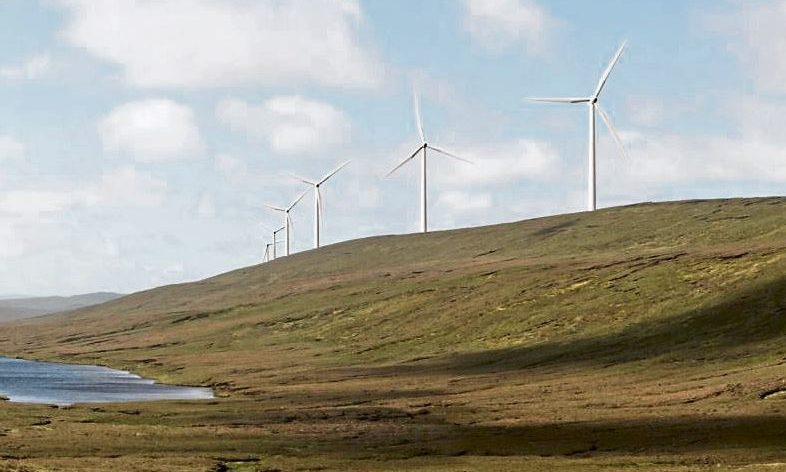
Nearly 1.6GW of Scottish onshore wind and solar projects will receive backing under the latest clean energy procurement round, marking a promising return for the cheapest forms of new energy generation.
In total, 11 gigawatts (GW) of renewables capacity won support in the fourth allocation round (AR4) of the UK’s flagship Contracts for Difference (CfD) auction.
Onshore wind and solar energy were both included in the auction for the first time since 2015.
Around 1.6GW of new onshore schemes will be built in Scotland, with projects securing 15-year agreements to supply power at set “strike prices”.
Onshore wind
Scotland secured all 888MW of onshore wind capacity in the UK-wide round, with most sites located in the Central Belt, Borders and Dumfries and Galloway.
Projects clinching support include Cumberhead West (119.7MW); Arecleoch Wind Farm Extension (74.10MW); Kilgallioch windfarm extension (51.3MW); Stranoch Wind Farm (99.9MW); North Kyle Energy Project (212MW); Hagshaw Hill Repowering (79.8MW); Broken Cross Wind Farm (48MW); Douglas West Extension (71.5MW); High Constellation Wind Farm (50MW); and Chirmorie Wind Farm (81.60MW).
All will receive the CfD strike price for onshore wind of £42.47/MWh.
Remote island wind
In addition, 597MW of “remote island wind” projects in Orkney, Shetland and the Isle of Lewis were allocated CfD support under their own category. These schemes will see a slightly elevated strike price of £46.39/MWh to reflect additional costs of development and transmission.
Winners include 200MW of capacity at the Stornoway Wind Farm being developed by EDF Renewables; two community-led developments in Orkney at Hoy and Quanterness (both 28.8MW); Mossy Hill near Lerwick (48MW) and Beaw Field on Yell (72MW).
Additionally, the Viking Wind Farm on Shetland won a contract to supply 220MW – 50% of its 443MW capacity – for the 2026/27 delivery year.
In an update, developer SSE Renewables said the project was progressing through construction, more than half of turbine foundation bases now poured.
Managing director Stephen Wheeler, said: “We are delighted that Viking Energy Wind Farm has been successful in securing a 15-year contract in the UK’s fourth and highly competitive CfD allocation round.
“Viking will be the most productive onshore wind farm in the UK when it enters operation from 2024, and will play a crucial role in decarbonising energy supply in the Shetland Islands as well as in Scotland.”
Commenting on his company’s success at both Stornoway and Stranoch, EDF Renewables UK’s CEO Matthieu Hue added: “This is fantastic news for our two projects which we are looking forward to building and further contributing to the UK’s net zero targets. Another 10.79 GW of renewables is definitely a hugely positive move in the right direction.
Mr Hue said the technologies were “cost competitive and quick to build” – particularly important factors as energy security and the cost of living remained in “sharp focus.”
However, he said the company was “disappointed” that its Blyth 2 floating wind farm off Northumberland in England was overlooked.
“We are disappointed our Blyth 2 project did not win a CfD as we firmly believe the project would be key to enabling more floating offshore wind projects. Our priority now will be to look at other ways to deliver this.”
Solar
All 78MW of solar capacity in Scotland was secured by one developer, Elgin Energy, which will see a trio of its projects across Aberdeenshire gain CfD support.
This includes the 49.9MW Milltown Airfield project near Elgin, 20MW Speyslaw scheme in Moray and 8.75MW of its Cullerlie site near Westhill, though the latter has been consented as a 13MW development.
All projects will receive a solar strike price of £45.99/MWh.
Scottish Renewables chief executive Claire Mack welcomed the onshore results, noting that: “Onshore wind provides the bulk of Scotland’s renewable electricity capacity cheaply, predictably and alongside a whole raft of other social, environmental and economic benefits.”
Ms Mack said the sector employs around 8,800 people across Scotland. “These are skilled jobs which bring prosperity and investment to communities where opportunities for this type of employment would otherwise not exist.”
She added that remote island wind pot has “a superb story to tell here” as new CfD-supported developments bring “new investment and jobs to communities which have waited for many years for them to proceed.”
The trade body also said the success of remote island projects would help make a further case for new transmission cables.
